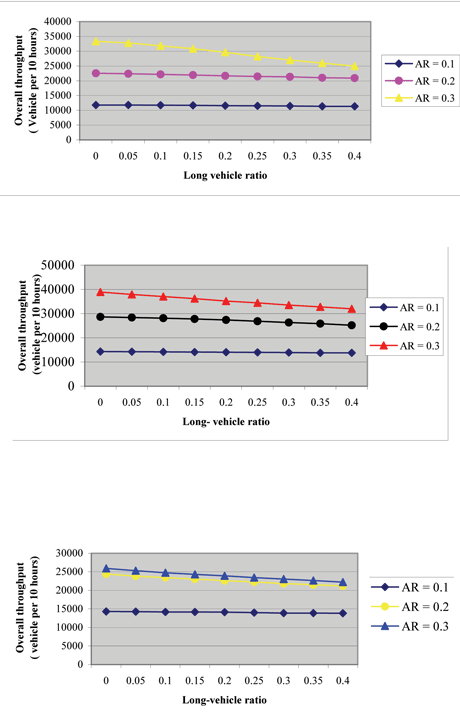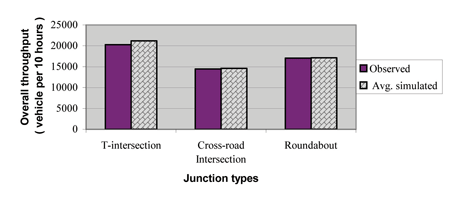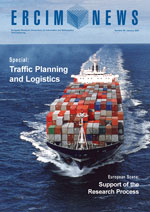by Puspita Deo and Heather J. Ruskin
Managing road networks requires a clear understanding of traffic flow, including causes of congestion or locations of traffic breakdowns. Scientists at Dublin City University are examining the influence of long-vehicle (LV) fraction on urban and inter-urban traffic flow through a road network. A two-component cellular automaton (2-CA) methodology is chosen for heterogeneous motorized traffic. The emphasis is on individual vehicle interactions for a binary mix of vehicle types, namely short (SV) and long vehicles for an urban single-lane junction and roundabout.
Traffic in Western or developed countries is characterized by a variety of motorized vehicles such as cars, buses, trucks and motorcycles. This differs from the situation in developing countries, which have diverse mixes of motorized and non-motorized vehicles, including bicycles, cargo tricycles and human- and animal-drawn carts (see Figures 1a and b). Control methods can also vary widely (Figure 1c), and together with the traffic mix, strongly influence urban network flows.


Traffic growth forecasts for Ireland for the period 2002-2040, made by the National Roads Authority (NRA), predict dramatic increases in both LGVs (cars and Light Goods Vehicles combined) and HGVs (Heavy Goods Vehicles). With large traffic volumes, breakdown of traffic flow is likely to occur, particularly on single-lane roads where all vehicles – regardless of whether they are turning or continuing on – wait in a single queue. (For example, see Figure 1c, depicting a local roundabout where few vehicles can be accommodated at any one time.) Nonetheless, most European cities still rely to some extent on single-lane connections to major arterial routes.
Our aim is to address questions relating to the effect of long vehicles on the operation of single-lane junctions and roundabouts. Field observations on traffic patterns can be difficult and time-consuming to obtain, meaning computer simulation models offer a viable alternative for in-depth study and can aid understanding of traffic dynamics. In this context, cellular automata (CA) have emerged as an efficient tool in modelling traffic flow at the individual unit level. Cellular automata approaches are based on discretisation of the continuous variables that describe the traffic flow, in order to define simple vehicle movement rules.
Two-Component Cellular Automata (2-CA) Model for Heterogeneous Motorized Traffic
In this study, heterogeneous motorized traffic flow is modelled at a single-lane junction and roundabout using 2-CA. The state of a road is described in terms of a set of linked cells occupied by at most one particle, corresponding to a standard car of length less than or equal to 7.5 metres. For simplicity, a long vehicle (LV) is taken to be double the length of a standard car (ie two cells are required for one LV). Thus, a short vehicle (SV) is understood to have a length of one cell, while an LV has a length of two. Both SV and LV will move exactly one cell in the next time step if the cell in front is vacant. For intersection and roundabout manoeuvres, an LV requires two time steps and an SV one time step to complete the manoeuvre from entry road onto the intersection or roundabout without causing interruption to flow. The model requires information such as length of entry roads, arrival rate, proportion of each vehicle type, turning rate and simulation time. In this approach, the developed models have been tested with local field data collected manually by Dublin City Council.
Simulations for Road Configurations
The purpose of the study is to ascertain the effect of long vehicles in the traffic mix on the throughput of signalized intersections and roundabouts. Figures 2 and 3 illustrate some results at different types of intersections for varying arrival rates (AR).

Based on these results, a number of points can be made:
With arrival rates taken to be equal on all entry roads, average overall throughput increases with arrival rate (AR) for homogeneous cases (SV traffic only) up to a critical AR. However, on increasing the proportion of LVs, this critical value is lowered significantly. In all cases (ie T-intersections, crossroad intersections and roundabouts), average throughput is reduced dramatically for large proportions of LVs (see Figure 2).
An increasing number of LVs in existing traffic streams is expected to worsen the already severe congestion problems present in many cities. From data collected by Dublin City Council, the approximate percentage of LVs is currently around 6%, creating roughly a 12% fall in capacity compared to homogeneous traffic.
When a network is already operating close to capacity (eg in peak hours), any increase in the proportion of LVs leads to severe bottlenecking and, in extreme cases, gridlock.
In the simple model described here, additional factors such as longer start-up times are not specifically incorporated, but would also add to delays caused by LV manoeuvres.
Even simple models can give reasonably good agreement with real data.
It is clear that investigations into the nature and impact of long vehicles in exclusively single-lane traffic are vital to understanding urban flows. Such shared roads constitute bottlenecks and dictate feeder traffic flow to larger arterial routes; the proportion of LVs in the local traffic has a significant impact on this.
Only one type of LV is considered here. Clearly, very large buses and trucks will have a different impact on road capacity.
The results of this research suggest that in the case of busy single-lane junctions and roundabouts, restrictions on LV movement will improve throughput to some extent. In the situations studied here, the primary justification for banning LVs is capacity and throughput rather than safety.
Future Work
Studies to date have led to a computationally efficient way of modelling heterogeneous (binary SV:LV mix) motorized traffic flow. Future work will explore vehicular behaviour and other types of LV for a variety of road geometries.
Links:
http://www.springerlink.com/content/274846j686gg0426/
Please contact:
Puspita Deo
Dublin City University, Ireland
E-mail: dpuspita![]() computing.dcu.ie
computing.dcu.ie
Heather J. Ruskin
Dublin City University, Ireland
E-mail: hruskin![]() computing.dcu.ie
computing.dcu.ie









